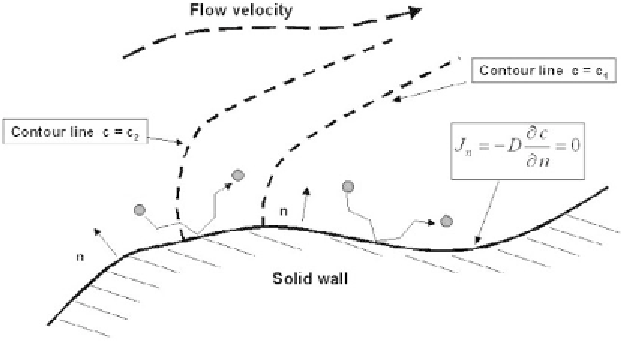Biomedical Engineering Reference
In-Depth Information
The second one is the condition is the homogeneous Neumann condition
c
n
, where
n
is the unit vector defining the normal direction to the wall. In
this case there is no mass flux from the concentration field to (or through) the wall
and it corresponds to a situation of no adherence of the transported species and the
wall (Figure 6.7).
Evidently, there exist more complicated boundary conditions, especially when
the mass flux to the wall is governed by a biochemical reaction. In such a case, the
mass flux at the wall is determined by the chemical reaction rate
¶
=
0
¶
¶
c
d
G
J
D
n
= -
=
(6.11)
n
¶
d t
d
d t
is the reaction kinetics. The boundary condition is the Neumann condition
G
where
¶
c
1
d
G
= -
(6.12)
¶
n
D d t
and we obtain the scheme of Figure 6.8 where a boundary layer of concentration
develops along the wall. This type of problem will be treated in Chapter 7.
6.2.4 Coupling with Hydrodynamics
The advection-diffusion equation is not sufficient to solve the complete problem by
itself. The velocity field must be known. The complete formulation is
¶
ρ
�
+ Ñ
.(
ρ
U
) 0
=
¶
t
�
� �
� �
¶
U
ρ
+
ρ
U U
.
Ñ = -Ñ + D +
P
η
U F
(6.13)
¶
t
�
¶
c
U c
.
.(
D c
)
S
+
Ñ = Ñ
Ñ +
¶
t
Figure 6.7
Homogeneous Neumann condition at the solid wall. Particles do not adhere on the
contact surface.







